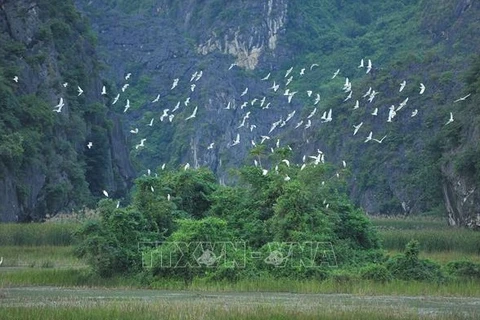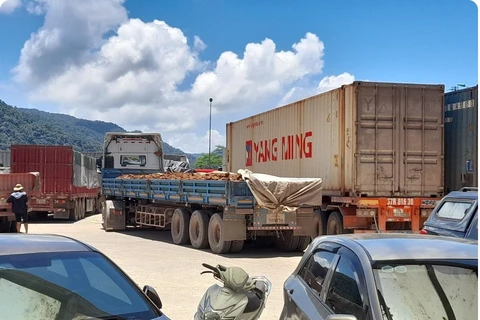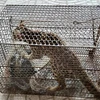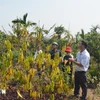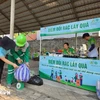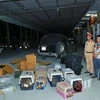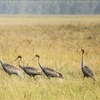Hanoi (VNA) – Ban Khok market in Salavane province of Laos has become one of the hotspots for the illegal trade of wildlife.
Upon hearing that VietnamPlus reporters wanted to buy civets and squirrels to bring back to Hanoi, Tinh, the owner of a grocery opposite to Ban Khok market, advised us not to buy wild meat at the market as it is often mixed with formaldehyde to keep it fresh for a long period of time.
He promised to provide wild animals with better quality and asked for phone numbers. Tinh boasted that he understands the business activities in the market very well after living in the neighbouring country for nearly 10 years.
Another trader at Ban Khok market also told VietnamPlus reporters that most wild animal products in this market are treated with preservatives to prevent them from decaying. She said that if they want to bring meat back to Vietnam, just pack it in a Styrofoam box, it won't rot for a few days.
She went on to say that she bought civets, squirrels and wild chickens from hunters.
Seeing that customers were very interested in wild animal products, the traders in the market continued to put up dead wild animals for sale.
The situation is common at many other markets in Laos such as Houay Aek, Thongnamy, Indochina, and especially Vang Vieng tourist market.
The one thing in common among the wild animals displayed on the tables at Lao markets was that they were all injured, or died by hunters’ bullets and didn’t have an unpleasant smell.
When asked about potential customers, most traders said that they sold wild animals and wild meat for tourists from Asia, including Vietnamese and Chinese.
Risk of contracting diseases from wild meat
Data from the World Wide Fund for Nature (WWF) showed that Laos, Vietnam, and Cambodia have observed the highest levels of wild meat consumption. The organisation also emphasised that the consumption of wild meat fuels the illegal wildlife trade, causing serious threats to global biodiversity.
The WWF also identified that the sale of wild animals at markets and consumption in restaurants pose a significant risk of transmitting zoonotic diseases to consumers.
According to Bui Dang Phong, Deputy Director of the Saving Threatened Wildlife Project Office, WWF-Vietnam, in the past, hunters usually used salt to preserve wild meat. However, later on, they switched to using formaldehyde as it is inexpensive and keeps the meat fresh for a long time, ensuring longer hunting trips.
Previously, when there were many wild animals, hunters would often return home with 10kg of wild meat after hunting for two days, but now they may have to spend a week or even longer. Therefore, formaldehyde is a "perfect choice" for hunters due to its low cost, and is not easily detected, he said.
Restaurants may be aware of the matter but ignore it for profit, Phong said, adding that those who consume products treated with formaldehyde face a serious health risk since it is an extremely toxic substance.
 Customers can select a variety of wild animal-related products at some markets in Laos (Photo: VietnamPlus)
Customers can select a variety of wild animal-related products at some markets in Laos (Photo: VietnamPlus) Scientists have already verified that formaldehyde is a known carcinogen and those who eat food containing this substance might be at risk of poisoning.
Deputy Chief of the Ha Tinh Forest Protection Department Truong Quoc Long agreed. He said traders inject formaldehyde into civets transported from Laos to keep the meat fresh for up to a month.
Apart from the health risks associated with consuming wild meat soaked in harmful preservatives, there emerged cases of fraud relating to endangered species, Long said. Many people have become victims, losing their money and gaining nothing in return.
Upon being informed that a household was making tiger bone glue, they carried out a raid on the premise, Long recalled. At that time, there were about seven people from Hai Phong and Hanoi waiting to buy the tiger bone glue.
Despite having a tiger skin and a cooking pot in the middle of their house, the other items proved fake as samples revealed different, he said. In fact, the raw materials for tiger bone glue didn’t come from tiger farms. The bones were from antelope and dog, as well as turtle shells.
Regarding the information about trafficking tigers from Laos to Vietnam, especially Ha Tinh province, Long said that most of the tiger bone glue being advertised and sold on the market is fake. There might be genuine products, but they are produced with tigers bred in Laos, he added.
Long went on to say that tigers are raised on farms like pigs in Khamkeut district of Bolikhamsai province and Khammouane province of Laos.
Possibility of disease transmission from wild animals
Nguyen Thi Thuy Hang, head of the Strategic Approach 4, which aims to reduce wildlife consumption, under the USAID Biodiversity Conservation project, WWF- Vietnam, said that the consumption of wildlife products is not only illegal but also poses danger to human health because wild animals contain many dangerous pathogens.
She cited the fact that scientists discovered the HIVvirus originating from chimpanzees, or the spread of African swine fever from wild boars to domestic pigs as an example.
Hang said that if avian flu spreads from wild birds to domestic poultry, then to humans, causing risk of a pandemic. That is the most dangerous thing about the trade.
CEO of WWF-Vietnam Van Ngoc Thinh also emphasised that most recent dangerous epidemics originate from wild animals, adding that pathogens might transmit through contact and consumption of wild animals.
Nguyen Van Tin, manager of the WWF-Vietnam Wildlife Conservation Programme, also said that the consumption of wild meat seriously reduces wildlife populations. It causes transboundary and domestic wildlife crime while significantly increasing the transmission of zoonotic diseases to humans.
Most consumers are not aware of potential risks that they are exposing to themselves, their relatives and society when they purchase wild meat, he noted.
Nowadays, disease outbreaks are emerging with increasing frequency given the closer and more frequent contact between humans and wild animals. An estimated 75% of new human diseases have come from animals over the last 30 years, said Nguyen Dao Ngoc Van, an advisor to WWF-Vietnam.
However, she noted that wild animals are not at fault nor are the agents that spread the diseases, but humans are the main reason as they intervene, change, and leave a big impact on wildlife habitats.
Human activities such as hunting, trading, transporting, raising, slaughtering and consuming wild animals create conditions for multiplying and transmitting agents. These include bacteria and viruses, parasites, and fungi from animals to humans.
Van went on to say that civets, pangolins, monkeys, porcupines, wild boars, deer and bamboo rats are wild animals that have a high risk of causing infectious diseases and transmitting diseases from animals to humans.
Acting Director of the Department of Animal Health under the Ministry of Agriculture and Rural Development Nguyen Van Long said scientists are conducting groundbreaking research that implicates eating wild meat as one of the reasons for outbreaks of diseases such as HIV/AIDS, Ebola, Middle East Respiratory Syndrome (MERS-Cov), COVID-19 pandemic or monkeypox./.


